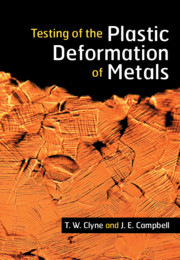Book contents
- Testing of the Plastic Deformation of Metals
- Reviews
- Testing of the Plastic Deformation of Metals
- Copyright page
- Contents
- Preface
- Nomenclature
- 1 General Introduction
- 2 Stresses, Strains and Elasticity
- 3 Continuum Plasticity
- 4 Mechanisms of Plastic Deformation in Metals
- 5 Tensile Testing
- 6 Compressive Testing
- 7 Hardness Testing
- 8 Indentation Plastometry
- 9 Nanoindentation and Micropillar Compression
- 10 Other Testing Geometries and Conditions
- Index
- References
6 - Compressive Testing
Published online by Cambridge University Press: 24 May 2021
- Testing of the Plastic Deformation of Metals
- Reviews
- Testing of the Plastic Deformation of Metals
- Copyright page
- Contents
- Preface
- Nomenclature
- 1 General Introduction
- 2 Stresses, Strains and Elasticity
- 3 Continuum Plasticity
- 4 Mechanisms of Plastic Deformation in Metals
- 5 Tensile Testing
- 6 Compressive Testing
- 7 Hardness Testing
- 8 Indentation Plastometry
- 9 Nanoindentation and Micropillar Compression
- 10 Other Testing Geometries and Conditions
- Index
- References
Summary
Testing in (uniaxial) compression is sometimes an attractive alternative to tensile testing. Specimens can be simpler in shape and smaller, since there is no gripping requirement. The key question is whether corresponding information can be obtained. In general, it can, but there is sometimes a perception that at least some materials behave differently under compression – i.e. that there is tensile-compressive asymmetry in their response. In fact, this is largely a myth: at least in the majority of cases, the underlying plasticity response is symmetrical (and indeed the von Mises (deviatoric) stress, which is normally taken to be the determinant of the response, is identical in the two cases). However, there are important caveats to append to this statement. For example, if the material response is indeed dependent on the hydrostatic component of the stress, as it might be for porous materials and for those in which a phase transformation occurs during loading, then asymmetry is possible. Also, while the underlying plasticity response is usually the same, the compressive stress–strain curve is often affected by friction between sample and platen (leading to barreling). Conversely, the necking that is likely to affect the tensile curve cannot occur in compression, although some kind of buckling or shearing instability is possible. It’s also important to distinguish the concept of tension/compression asymmetry from that of the Bauschinger effect (a sample pre-loaded in tension exhibiting a different response if then loaded in compression).
- Type
- Chapter
- Information
- Testing of the Plastic Deformation of Metals , pp. 107 - 122Publisher: Cambridge University PressPrint publication year: 2021

